We are all familiar with the core areas of learning: “Reading, Writing, and Arithmetic”, or more recently, the focus on the STEM and STEAM initiatives. These are meant to remind us of the basic skills that students need to be taught in school. These skills even need to be taught to the littlest learners: preschoolers! But, how much attention beyond rote counting is really given to math in preschool?
Well, according to one study, only 58 seconds per day was spent on math in preschools with six-hour days. Likewise, a 2017 study by Vanderbilt University education professor Dale Farran found that math was only taught intentionally 2.5 percent of the day in her study of preschool classrooms. However, they found that increasing the amount of time children spend engaged in math from 2 percent to just 4 percent led to significant math gains.
Why so little time devoted to math? Could it be for those of us who teach preschool children, just the mere thought of MATH makes us feel a little woozy? (I know this happens to me!) When we think of math, we conjure up thoughts of high school geometry or calculus and feel intimidated as to where to even begin with Pre-K children. But, keep in mind this is Pre-K, and I have no doubt that each and every one of us should be confident that we can do Pre-K math!
Being confident is a first step, but we also need to make sure we are equipped with an understanding of what Pre-K children need to know and how to best teach them. We are all aware that just singing the ABCs does not teach our children how to read. Likewise, it is important to keep in mind that rote counting of the 123s does not teach our children anything more than a list of number words in order. We must intentionally teach children what those numbers mean (number sense)—and more!
Math skills as predictor for later life success
Why is teaching math to preschool children so important? First, it has been found that math skills can be a predictor for later-life success—more so than reading. In "School Readiness and Later Achievement," a widely cited 2007 study by education professor Greg Duncan found that "early math concepts, such as knowledge of numbers and ordinality, were the most powerful predictors of later learning" in a comparison of math, literacy, and social-emotional skills at kindergarten entry.
Math encourages creative thinking and problem solving
Secondly, if we keep in mind that math provides the basis for vital skills later in life, this may lessen the intimidation factor of math. It’s obvious we need math in daily life for budgeting, to double or halve a recipe, or determine if we receive the correct change at a store. But a strong math foundation also provides skills for problem-solving and critical-thinking that are vital to success and safety in all aspects of our life. According to Dr. Jie-Qi (Jackie) Chen, professor of Child Development at the Erikson Institute, “Developing a mentally organized way of thinking is critical.” To make that happen, Chen says, “We need to provide high-quality math education at an early age.”
Investing time and effort in teaching preschool children math is extremely important, but what skills do we teach and where do we begin? To best support the development of Pre-K math skills, it's important to understand the specific foundation skills preschool-level children need to know.
What math skills should Pre-K students be learning?
Taking into consideration child development and what skills children need to know and when, Get Set for School® by Learning Without Tears is a developmentally appropriate, child friendly curriculum that provides teachers with easy-to-follow lessons and materials that will engage and entice children to learn and play.
We understand the importance of building a strong foundation of ALL skills for ALL preschool children. Get Set for School is a complete curriculum with math being just one of the core learning areas. All learning areas are intentionally designed to be developmentally appropriate.
Below, you’ll find the core skills taught in the daily Get Set for School math lessons. While all these areas are important for math development, the first two, Number & Operations and Geometry, are foundational to future math learning. Therefore, they are a fundamental part of many Get Set for School math lessons. Numbers & Operations is basically “number sense,” which has been shown to be the building block for all other math skills. These skills encourage children to think flexibly and promote confidence with numbers and solving problems. Let’s take a closer look:
Numbers & Operations
- Pre-K children develop number sense, investigate relationships among numbers, and explore the properties of numbers. Children know numbers in a practical way long before they do math activities. They know that they have one mouth and two hands before they recognize 1 and 2. They know that they want more, even before they know the word “more.” What we teach children in Number & Operations are words and symbols for what they already know, while expanding their basic ideas about numbers to a solid understanding of quantities.
Geometry
- Geometry is the study of shapes and space. When children play on the playground, they begin to learn words to describe where they are (e.g., on the ladder, under the slide). Children should build their vocabulary with position words through songs, games, and activities. They also play, build, and explore with shapes. In Pre-K, children can move beyond simple identification of shapes to understand each shape’s characteristics.
Patterns & Algebra
- Algebra is an area of math that uses symbols, letters, and patterns to solve problems. Children love to notice and make patterns. Seeing and extending patterns help children build observation, thinking, and problem-solving skills. Simple repetitive patterns and even simple growing patterns can be explored with young children. Pattern activities build the foundation for understanding more complex mathematical patterns in the future.
Measurement & Time
- Measurement is determining the size or amount of something. Young children acquire these skills through measuring objects themselves. Children can experience measuring by making direct comparisons between objects, comparing objects using nonstandard units, such as paper clips or straws, and comparing objects using standard units. They learn to measure with nonstandard units first to prepare them to work with standard units in the future. When Pre-K children learn about time, they think about general times of day and what happens in their lives at those times.
Data Representation & Probability
- Data representation activities help children organize information (answers to questions) in a visual way. They are a good way to connect questions in children’s real worlds with numbers. Pictographs can be created in response to almost any Pre-K question, such as favorite ice cream or number of pets. Probability helps us answer questions about our world about the likelihood of future events. It helps children make sense of their day and world.
Understanding what to teach preschool children is very important. But then how do we teach, what materials do we use, and how do we set up appropriate lessons?
Get Set for School Math Activities for Pre-K
Math makes sense to children when they have hands-on experience with it! Therefore, in the Pre-K classroom, math needs to be hands-on, multisensory, engaging, and fun!
The following math activities highlight just a few of the math products available from Get Set for School. Lessons incorporating these products are included in the complete Get Set for School curriculum, and each product also comes with its own activity booklet. Use these products for teacher directed instruction, but they are also perfect for child-led discovery play, too!
Activity 1. I Know My Numbers
A set of number booklets, one for each number 1–10, helps children develop number sense with finger plays, songs, rhymes. Each child has their own set of booklets full of coloring activities and numeral tracing.
- Sample Activity from I Know My Numbers (Booklet #6): (Download a sample)
- Take 6 small condiment cups and 6 caps: What can you do? Count, teach on/in, up/down, etc.

- Take 6 small condiment cups and 6 caps: What can you do? Count, teach on/in, up/down, etc.
Activity 2. 4 Squares More Squares®
Bring geometry to life as children slide, turn, and flip colorful sturdy rubber pieces. Children can also sort, sequence, pattern, solve puzzles, and develop spatial awareness. (Download a sample)
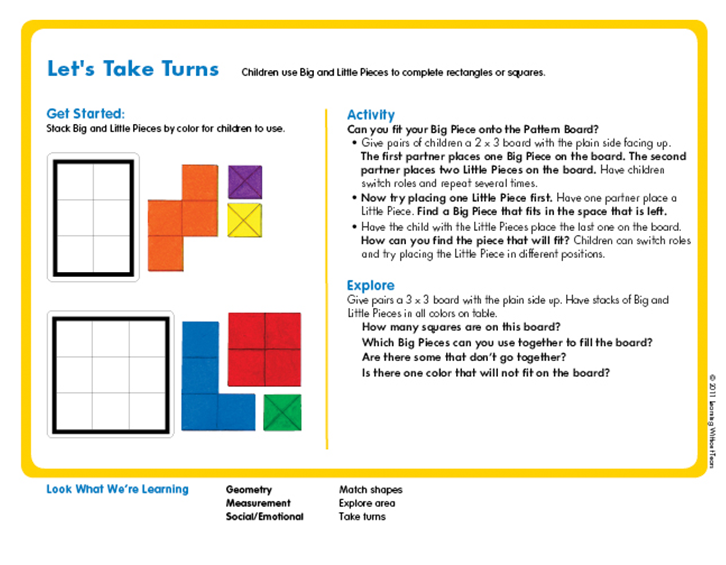
Activity 3. Tag Bags®
Children will eagerly engage with these colorful bags as they identify numerals, sort, match, measure, pattern, and build! Each bag has a fastener that they open/close to foster fine motor skills. (Download a sample)
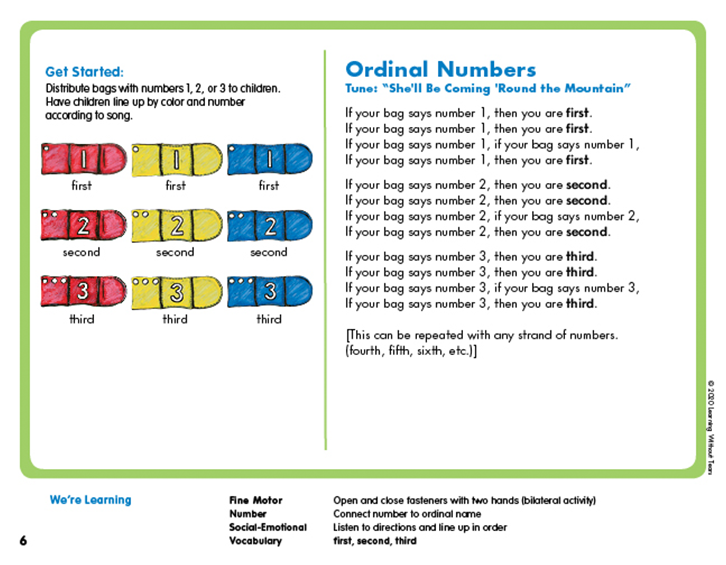
Activity 4. Mix & Make Shapes™
Mix & Make Shapes are brightly colored foam pieces that invite children to sort, trace, transform, and move shapes as they learn about shape properties, size, and much more. (Download a sample)
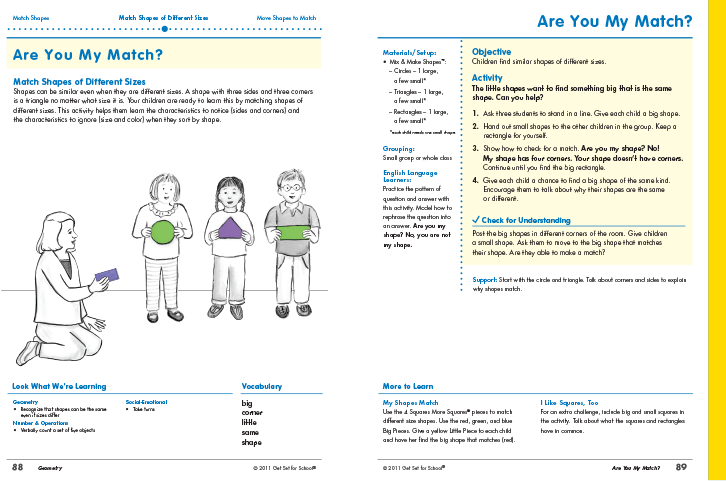
Activity 5. 1-2-3 Touch & Flip Cards®
These tactile, double-sided cards entice children to trace and name numbers, count, and sequence. The “flip" feature helps students check their work! (Download a sample)
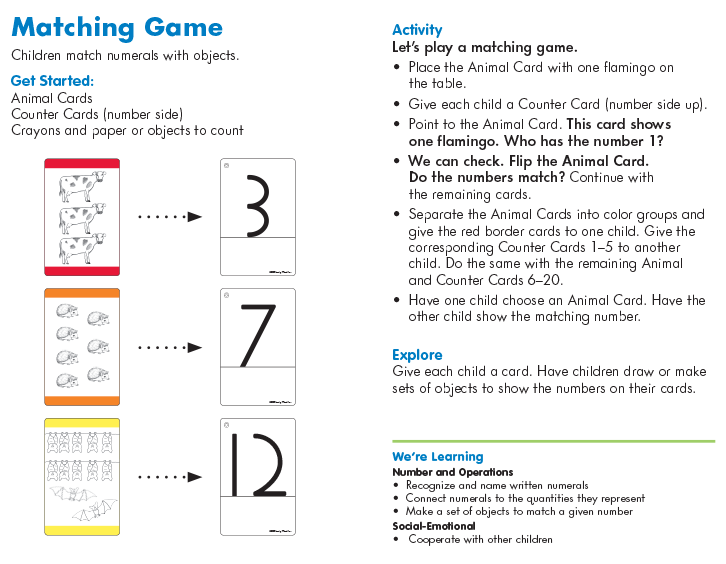
Activity 6. Sing, Sound & Count with Me Album (Check out our music samples page)
With this music album, children learn language and number concepts as they move and play to upbeat songs that reinforce your instruction.
- Specific math songs: 5 Fingers Play, Shape Song, Counting Candles, Pattern Dance, Counting at the Table, Big Numbers, The Ants Go Marching, and Counting, Counting.
- When you sing math songs, add visuals and/or objects to count to enhance learning.
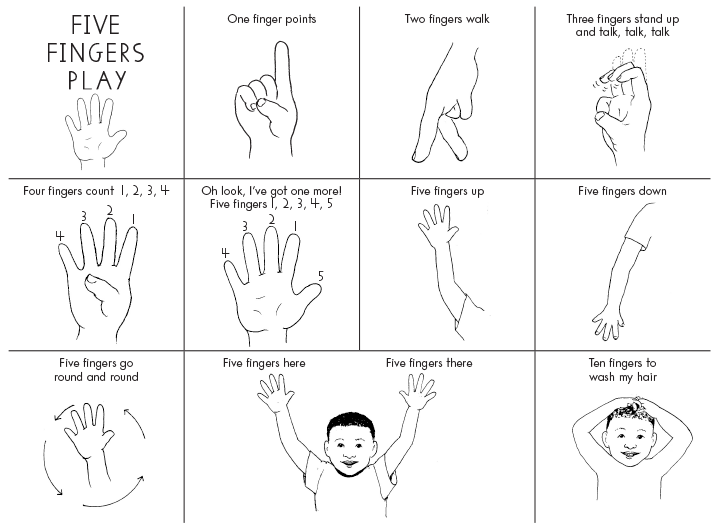
Teaching Tip: Make it Cross-Curricular
Although we need to teach math concepts explicitly, it is also important to help children understand that math happens everywhere! This can be done easily when we are intentional with typical classroom and play activities. In fact, one of the most powerful teaching strategies is to integrate or blend math into other subjects (reading, art, science, snack and line up time, on the playground, etc.). This helps children understand that math is functional, and numbers, shapes, and patterns happen every day in the real world.
Get Set for Math and Beyond
Get Set for School provides child-friendly and developmentally appropriate tools and support, allowing both preschool students and teachers to be successful and excited about learning. View our complete selection of Numbers and Math products available to support development in all foundational math areas. If you are looking for more developmentally appropriate programming beyond math, check out our complete Get Set for School curriculum, which focuses on all the core learning areas necessary in preschool: Numbers & Math, Readiness & Writing, Language & Literacy, Oral Language, and Science & Social Studies.
Don’t forget to check out our teacher and OT training workshops and webinars to help teachers feel more equipped and confident. Happy teaching!